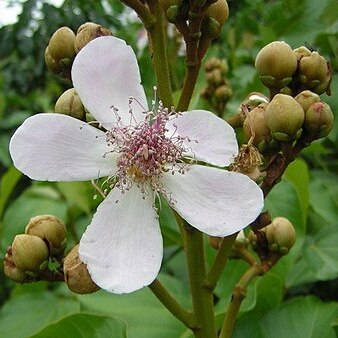Shrubs or small trees. Young branches and leaves with peltate scales. Leaves alternate; stipules small, sheathing bud, fugacious; petiole swollen at base and apex; leaf blade simple, palmately veined. Inflorescence a terminal panicle. Flowers bisexual, actinomorphic. Sepals 5, free, imbricate, with basal, abaxial glands, fugacious. Petals 5, imbricate, large and conspicuous. Stamens many, free or slightly united at base; anthers oblong, with 2 inverted, U-shaped thecae, dehiscing by short, apical slits on bend. Ovary superior, 1-loculed; ovules many on 2 parietal placentas; style slender; stigmas 2-lobed. Fruit a capsule, loculicidally 2-valved, usually spiny. Seeds many; testa red, slightly fleshy; embryo large; cotyledons broad, incurved at apex; endosperm copious.
Trees or shrubs. Leaves alternate, palmately nerved at base, stipulate. Flowers 4–6 cm diam., bisexual, somewhat zygomorphic, in panicles or racemes. Sepals 4 or 5, free, imbricate, caducous. Petals 5, sometimes 4–7, free, imbricate in bud. Stamens numerous, hypogynous; filaments free; anthers bilocular, straight or horseshoe-shaped, opening by apical pores which are often confluent. Ovary superior, unilocular, 2–5–carpellate; placentation parietal; ovules many; style simple. Fruit a loculicidal capsule. Seeds often cottony; endosperm copious.
Ovary superior, 1-celled, with 2 parietal placentas; ovules numerous; style slender, recurved in bud; stigma 2-lobed
Seeds obovoid; testa rather fleshy, red; endosperm copious; embryo large; cotyledons broad, incurved at the apex
Ovary superior, usually bristly, 1-locular, multiovulate with 2 parietal placentas; style 1, stigma 2-lobed
Fruit a densely echinate-setose or smooth capsule, 2-valved; valves thick, with the placentas in the middle
Stamens numerous, hypogynous; filaments free; anthers horse-shoe-shaped, opening by short slits at the top
Fruit a densely echinate-setose or smooth capsule, 2-valved; valves thick with the placentas in the middle
Flowers in terminal corymbs or panicles, bisexual, actinomorphic; pedicels with 5–6 apical glands
Seeds numerous; testa fleshy, densely studded with red glands; endosperm copious; embryo large
Sepals 5, imbricate, deciduous, with a large fleshy gland at the base outside
Stamens ?, inserted on an annular disk; anthers opening by pore-like slits
Sepals 4–5, free, imbricate in bud, falling off when the flower expands
Leaves alternate, petiolate, simple, palmatinerved, stipulate
Petals 5, large, imbricate, without a scale at the base
Flowers hermaphrodite, medium-sized, showy, paniculate
Leaves alternate, simple, palminerved, stipulate
Shrubs or small trees with coloured juice
Shrubs or small trees with coloured juice
Petals 4–7, free, imbricate in bud
Disk none

